Cyclonic and Anticyclonic Asymmetry of Reef and Atoll Wakes in the Xisha Archipelago
Abstract
1. Introduction
2. Model and Data
2.1. XA-FVCOM
2.2. Observational Data
2.3. Model Validation
3. Cyclone–Anticyclone Asymmetry in the XA
3.1. Wake Eddy Shedding Process
3.2. Cyclone–Anticyclone Asymmetry
4. Discussion
4.1. Intrinsic Dynamical Properties of the Flow
4.2. Effects of Reefs and Atolls
5. Conclusions
Author Contributions
Funding
Data Availability Statement
Conflicts of Interest
Abbreviations
| XA | Xisha Archipelago |
| SCS | South China Sea |
| WBC | Western Boundary Current |
| CWEs | cyclonic wake eddies |
| AWEs | anticyclonic wake eddies |
| VGED | vector-geometry-based eddy detection algorithm |
| ICI | inertial–centrifugal instability |
| OW | Okubo–Weiss |
| probability density function | |
| MLD | mixing layer depth |
Appendix A
References
- Doty, M.; Oguri, M. The island mass effect. ICES J. Mar. Sci. 1956, 22, 33–37. [Google Scholar] [CrossRef]
- Arístegui, J.; Tett, P.; Hernández-Guerra, A.; Basterretxea, G.; Montero, M.; Wild, K.; Sangrá, P.; Hernández-Leon, S.; Canton, M.; García-Braun, J.; et al. The influence of island-generated eddies on chlorophyll distribution: A study of mesoscale variation around Gran Canaria. Deep Sea Res. Part I: Oceanogr. Res. Pap. 1997, 44, 71–96. [Google Scholar] [CrossRef]
- Caldeira, R.; Groom, S.; Miller, P.; Pilgrim, D.; Nezlin, N. Sea-surface signatures of the island mass effect phenomena around Madeira Island, Northeast Atlantic. Remote Sens. Environ. 2002, 80, 336–360. [Google Scholar] [CrossRef]
- Caldeira, R.; Marchesiello, P.; Nezlin, N.; DiGiacomo, P.; McWilliams, J. Island wakes in the Southern California Bight. J. Geophys. Res. Ocean. 2005, 110, 1–12. [Google Scholar] [CrossRef]
- Andrade, I.; Sangrà, P.; Hormazabal, S.; Correa-Ramirez, M. Island mass effect in the Juan Fernández Archipelago (33 °S), Southeastern Pacific. Deep Sea Res. Part I: Oceanogr. Res. Pap. 2014, 84, 86–99. [Google Scholar] [CrossRef]
- Stegner, A. Oceanic island wake flow in laboratory. Modelling Atmospheric and Oceanic Flows Insights from Laboratory Experiments and Numerical Simulations, 1st ed.; John Wiley & Sons: Hoboken, NJ, USA, 2014. [Google Scholar]
- McWilliams, J.C.; Weiss, J.B.; Yavneh, I. Anisotropy and coherent vortex structures in planetary turbulence. Science 1994, 264, 410–413. [Google Scholar] [CrossRef]
- Yavneh, I.; Shchepetkin, A.F.; Mcwilliams, J.C.; Graves, L.P. Multigrid solution of rotating, stably stratified flows. J. Comput. Phys. 1997, 136, 245–262. [Google Scholar] [CrossRef]
- Koszalka, I.; Bracco, A.; Mcwilliams, J.C.; Provenzale, A. Dynamics of wind-forced coherent anticyclones in the open ocean. J. Geophys. Res. Ocean. 2009, 114, C08011. [Google Scholar] [CrossRef]
- Raapoto, H.; Martinez, E.; Petrenko, A.; Doglioli, A.M.; Maes, C. Modeling the wake of the Marquesas Archipelago. J. Geophys. Res. Ocean. 2018, 123, 1213–1228. [Google Scholar] [CrossRef]
- Roullet, G.; Klein, P. Cyclone-anticyclone asymmetry in geophysical turbulence. Phys. Rev. Lett. 2010, 104, 218501. [Google Scholar] [CrossRef]
- Calil, P.H.; Richards, K.J.; Jia, Y.; Bidigare, R.R. Eddy activity in the lee of the Hawaiian Islands. Deep-Sea Res. Part II Top. Stud. Oceanogr. 2008, 55, 1179–1194. [Google Scholar] [CrossRef]
- Zhao, Z.; Li, J.; Zhao, W.; Yang, J.; Qi, S.; Xu, M. A numerical study of island wakes in the Xisha Archipelago associated with mesoscale eddies in the spring. Ocean Model. 2019, 139, 101406. [Google Scholar] [CrossRef]
- Cushman-Roisin, B. Frontal geostrophic dynamics. J. Phys. Oceanogr. 1986, 16, 132–143. [Google Scholar] [CrossRef]
- Perret, G.; Stegner, A.; Farge, M.; Pichon, T. Cyclone-anticyclone asymmetry of large-scale wakes in the laboratory. Phys. Fluids 2006, 18, 036603. [Google Scholar] [CrossRef]
- Lazar, A.; Stegner, A.; Heifetz, E. Inertial instability of intense and stratified anticyclones. Part I: Linear analysis and marginal stability criterion. J. Fluid Mech. 2013, 732, 457–484. [Google Scholar] [CrossRef]
- Lazar, A.; Stegner, A.; Caldeira, R.; Dong, C.; Didelle, H.; Vuiboud, S. Inertial instability of intense and stratified anticyclones. Part II: Laboratory experiments. J. Fluid Mech. 2013, 732, 485–509. [Google Scholar] [CrossRef]
- Ye, Z.; He, Q.; Zhang, M.; Han, C.; Li, H.; Ju, L.; Wu, J. Classification and characteristics of islands in the Xisha Archipelago. Mar. Geol. Quat. Geol. 1985, 5, 1–13. [Google Scholar]
- Dale, W. Wind and drift currents in the South China Sea. Malays. J. Trop. Geogr. 1956, 8, 1–31. [Google Scholar]
- Metzger, E. Upper ocean sensitivity to wind forcing in the South China Sea. J. Oceanogr. 2003, 59, 783–798. [Google Scholar] [CrossRef]
- Wang, G.; Su, J.; Chu, P. Mesoscale eddies in the South China Sea observed with altimeter data. Geophys. Res. Lett. 2003, 30, 2121. [Google Scholar] [CrossRef]
- Nan, F.; He, Z.; Zhou, H.; Wang, D. Three long-lived anticyclonic eddies in the northern South China Sea. J. Geophys. Res. Ocean. 2011, 116, 1–15. [Google Scholar] [CrossRef]
- Hou, H.; Xie, Q.; Xue, H.; Shu, Y.; Nan, F.; Yin, Y.; Yu, F. Formation of an anticyclonic eddy and the mechanism involved: A case study using cruise data from the northern South China Sea. J. Oceanol. Limnol. 2019, 37, 1481–1494. [Google Scholar] [CrossRef]
- Shu, Y.; Xue, H.; Wang, D.; Xie, Q.; Chen, J.; Li, J.; Chen, R.; He, Y.; Li, D. Observed evidence of the anomalous South China Sea western boundary current during the summers of 2010 and 2011. J. Geophys. Res. Ocean. 2016, 121, 1145–1159. [Google Scholar] [CrossRef]
- Wang, D.; Liu, Q.; Xie, Q.; He, Z.; Zhuang, W.; Shu, Y.; Xiao, X.; Hong, B.; Wu, X.; Sui, D. Progress of regional oceanography study associated with western boundary current in the South China Sea. Chin. Sci. Bull. 2013, 58, 1205–1215. [Google Scholar] [CrossRef]
- Li, L. Seasonal circulation in the South China Sea-a TOPEX/POSEIDON altimetry study. Acta Oceanol. Sin. 2000, 22, 13–26. [Google Scholar]
- Wang, G.; Wang, C.; Huang, R.X. Interdecadal variability of the eastward current in the South China Sea associated with the summer Asian monsoon. J. Clim. 2010, 23, 6115–6123. [Google Scholar] [CrossRef]
- Hwang, C.; Chen, S. Circulations and eddies over the South China Sea derived from TOPEX/POSEIDON altimetry. J. Geophys. Res. Ocean. 2000, 105, 23943–23965. [Google Scholar] [CrossRef]
- Hu, J.; Kawamura, H.; Hong, H.; Qi, Y. A review on the currents in the South China Sea: Seasonal circulation, South China Sea warm current and Kuroshio intrusion. J. Oceanogr. 2000, 56, 607–624. [Google Scholar] [CrossRef]
- Chi, P.C.; Chen, Y.; Lu, S. Wind-driven South China Sea deep basin warm-core/cool-core eddies. J. Oceanogr. 1998, 54, 347–360. [Google Scholar] [CrossRef]
- Chen, X. The basis of modern climatology. In The Basis of Modern Climatology; Nanjing University Press: Nanjing, China, 2014; pp. 53–56. [Google Scholar]
- Wang, D.; Zhou, F.; Li, Y. Annual cycle characteristics of surface water temperature and sea surface heat budget in the South China Sea. Acta Oceanol. Sin. 1997, 19, 33–44. [Google Scholar]
- Gao, R.; Zhou, F. Monsoonal characteristics revealed by intraseasonal variability of Sea Surface Temperature (SST) in the South China Sea (SCS). Geophys. Res. Lett. 2002, 29, 63-1–63-4. [Google Scholar] [CrossRef]
- Zhao, Z.; Li, J.; Zhao, W.; Yang, J.; Qi, S.; Xu, M. Features and dynamics of island wakes in the Xisha Archipelago associated with mesoscale eddies. In Proceedings of the International Workshop on Tropical-Subtropical Weather, Climate and Oceans, Guangzhou, China, 18 November 2017. [Google Scholar]
- Perfect, B.; Kumar, N.; Riley, J.J. Vortex structures in the wake of an idealized seamount in rotating, stratified flow. Geophys. Res. Lett. 2018, 45, 9098–9105. [Google Scholar] [CrossRef]
- Qin, Y.; Wu, S.; Betzler, C. Backstepping patterns of an isolated carbonate platform in the northern South China Sea and its implication for paleoceanography and paleoclimate. Mar. Pet. Geol. 2022, 146, 105927. [Google Scholar] [CrossRef]
- Wu, Y.; Cheng, G. Seasonal and inter-annual variations of the mixed layer depth in the South China Sea. Mar. Forecast. 2013, 30, 9–17. [Google Scholar]
- Yan, T.; Qi, Y.; Jing, Z.; Cai, S. Seasonal and spatial features of barotropic and baroclinic tides in the northwestern South China Sea. J. Geophys. Res. Ocean. 2020, 125, e2018JC014860. [Google Scholar] [CrossRef]
- Chen, C.; Liu, H.; Beardsley, R. An unstructured grid, finite-volume, three-dimensional, primitive equations ocean model: Application to coastal ocean and estuaries. J. Atmos. Ocean. Technol. 2003, 20, 159–186. [Google Scholar] [CrossRef]
- Chen, C.; Beardsley, R.; Cowles, G. An Unstructured Grid, Finite-Volume Coastal Ocean Model: FVCOM User Manual; SMAST/UMASSD; 2006; unpublished manual. [Google Scholar]
- Chen, C.; Beardsley, R.; Cowles, G.; Qi, J.; Lai, Z.; Gao, G.; Stuebe, D.; Xu, Q.; Xue, P.; Ge, J. An Unstructured-Grid, Finite-Volume Community Ocean Model: FVCOM User Manual; Sea Grant College Program, Massachusetts Institute of Technology: Cambridge, MA, USA, 2012. [Google Scholar]
- Chassignet, E.; Hurlburt, H.; Smedstad, O.; Halliwell, G.; Hogan, P.; Wallcraft, A.; Baraille, R.; Bleck, R. The HYCOM (HYbrid Coordinate Ocean Model) data assimilative system. J. Mar. Syst. 2007, 65, 60–83. [Google Scholar] [CrossRef]
- Chassignet, E.; Smith, L.; Halliwell, G.; Bleck, R. North Atlantic simulations with the Hybrid Coordinate Ocean Model (HYCOM): Impact of the vertical coordinate choice, reference pressure, and thermobaricity. J. Phys. Oceanogr. 2003, 33, 2504–2526. [Google Scholar] [CrossRef]
- McClain, E.; Pichel, W.; Walton, C. Comparative performance of AVHRR-based multichannel sea surface temperatures. J. Geophys. Res. Ocean. 1985, 90, 11587–11601. [Google Scholar] [CrossRef]
- Ye, H.; Sheng, J.; Tang, D.; Siswanto, E.; Kalhoro, M.A.; Sui, Y. Storm-induced changes in pCO2 at the sea surface over the northern South China Sea during Typhoon Wutip. J. Geophys. Res. Ocean. 2017, 122, 4761–4778. [Google Scholar] [CrossRef]
- Nencioli, F.; Dong, C.; Dickey, T.; Washburn, L.; Mcwilliams, J.C. A vector geometry-based eddy detection algorithm and its application to a high-resolution numerical model product and high-frequency radar surface velocities in the Southern California Bight. J. Atmos. Ocean. Technol. 2010, 27, 564–579. [Google Scholar] [CrossRef]
- Zhao, Z.; Zhao, W.; Chen, Z.; Yang, J. Study of island mass effect in the Xisha Archipelago based on the MODIS satellite data. In Proceedings of the SPIE 11529, Remote Sensing of the Ocean, Sea Ice, Coastal Waters, and Large Water Regions, Online, 20 September 2020. [Google Scholar]
- Van Tuyl, J.; Alves, T.M.; Cherns, L. Geometric and depositional responses of carbonate build-ups to Miocene sea level and regional tectonics offshore northwest Australia. Mar. Pet. Geol. 2018, 94, 144–165. [Google Scholar] [CrossRef]
- Van Tuyl, J.; Alves, T.; Cherns, L.; Antonatos, G.; Burgess, P.; Masiero, I. Geomorphological evidence of carbonate build-up demise on equatorial margins: A case study from offshore northwest Australia. Mar. Pet. Geol. 2019, 104, 125–149. [Google Scholar] [CrossRef]
- Liu, H.; Jiang, L.; Qi, Y.; Mao, Q.; Cheng, X. Seasonal variabilities in mixed layer depth in the Nansha Islands sea area. Adv. Mar. Sci. 2007, 25, 268–279. [Google Scholar]
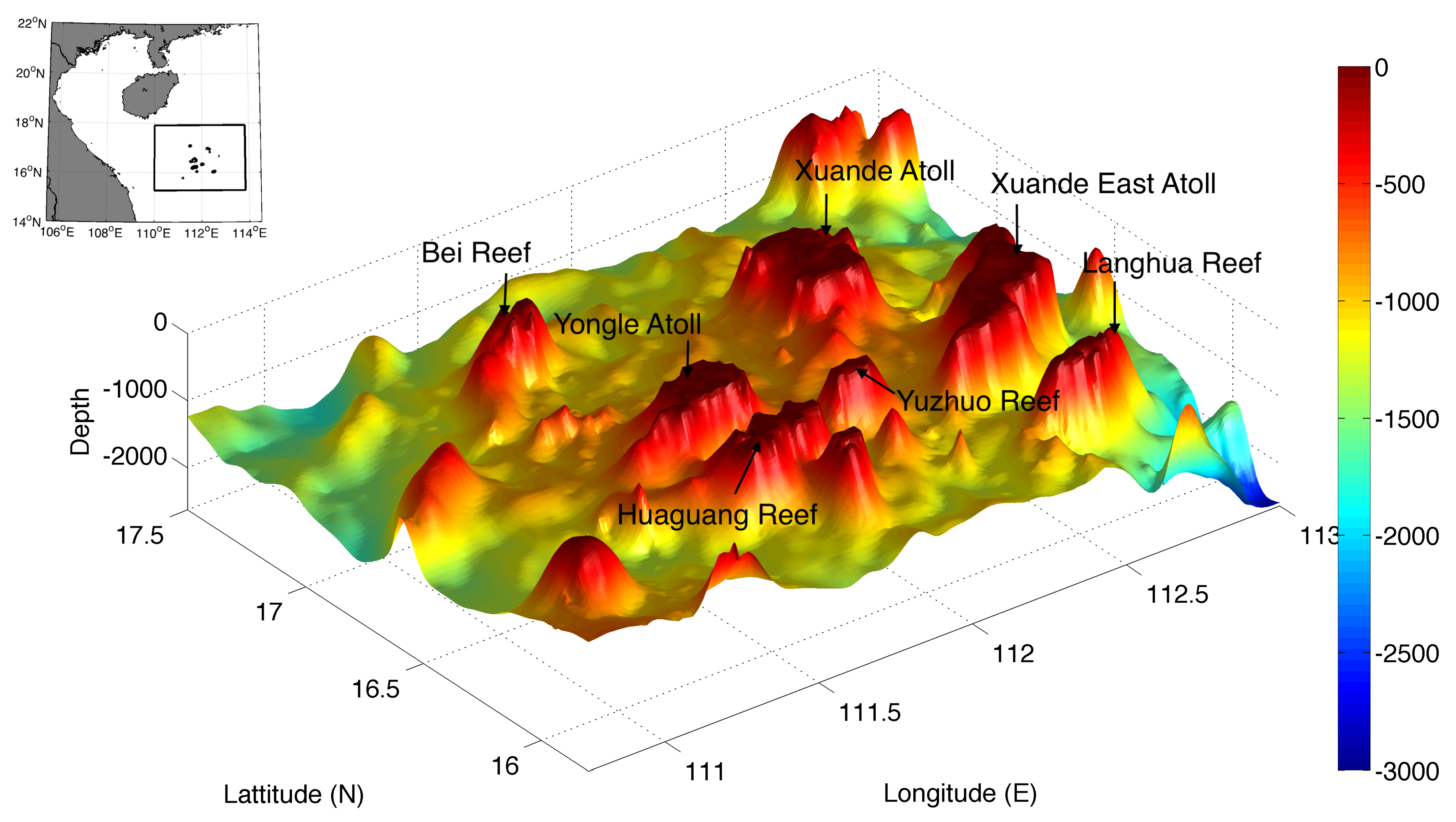
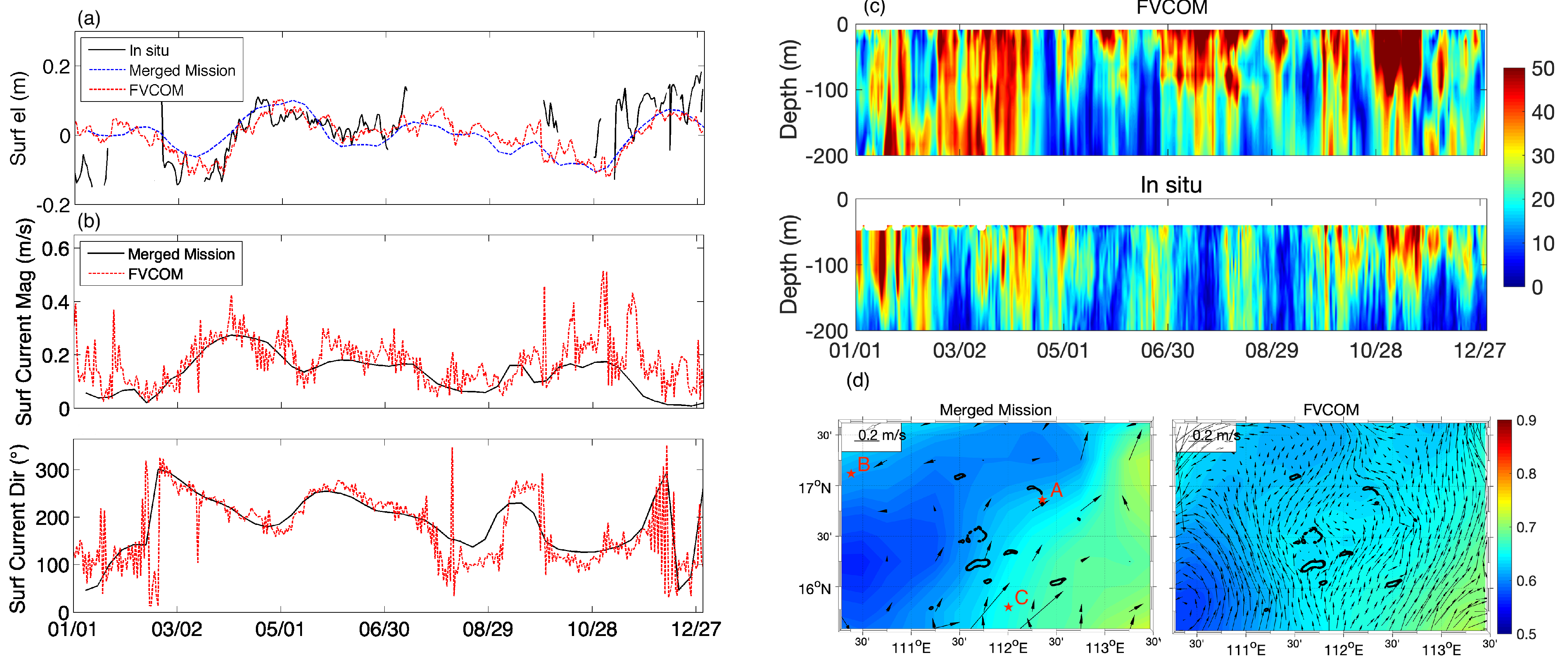

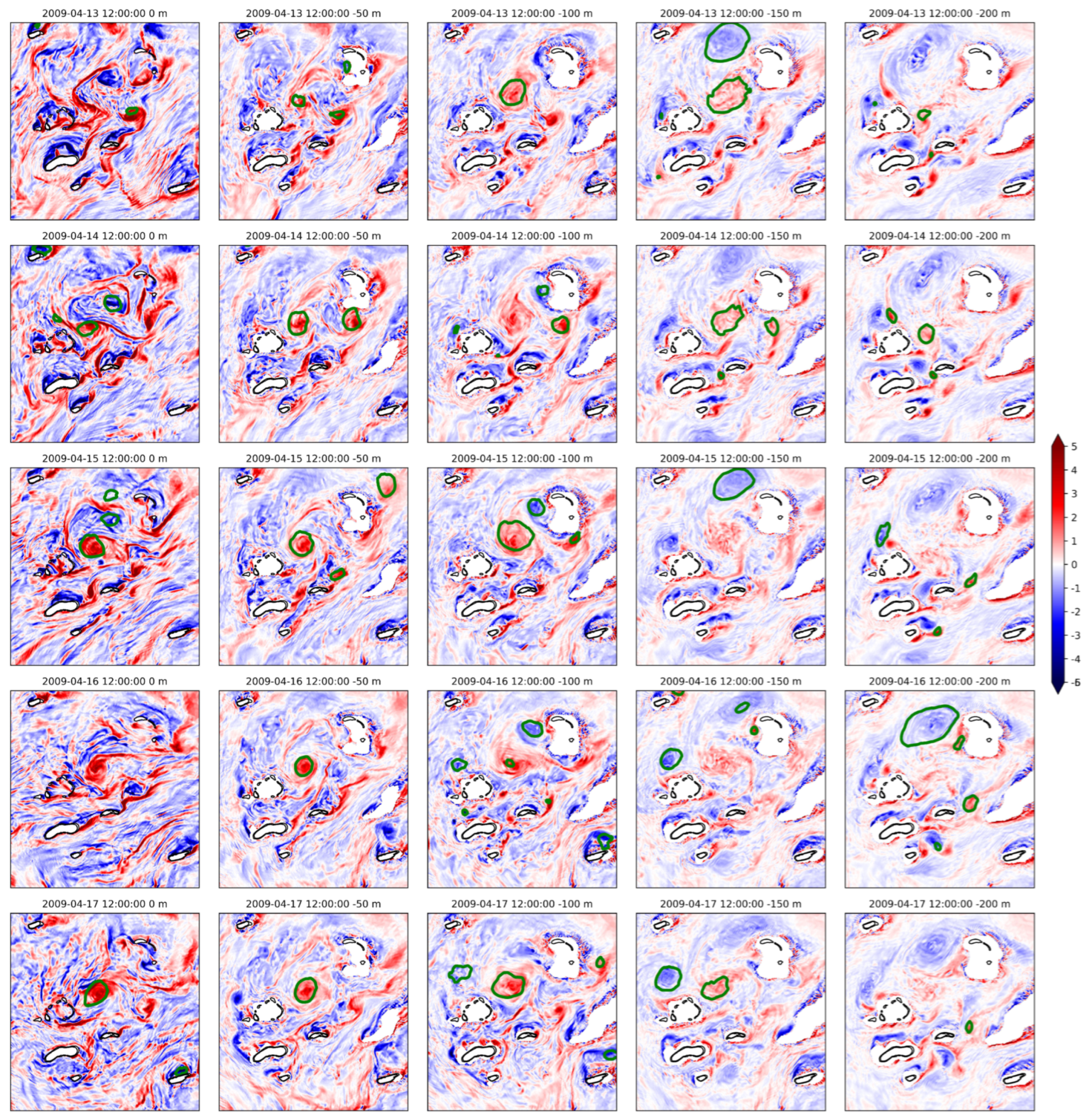

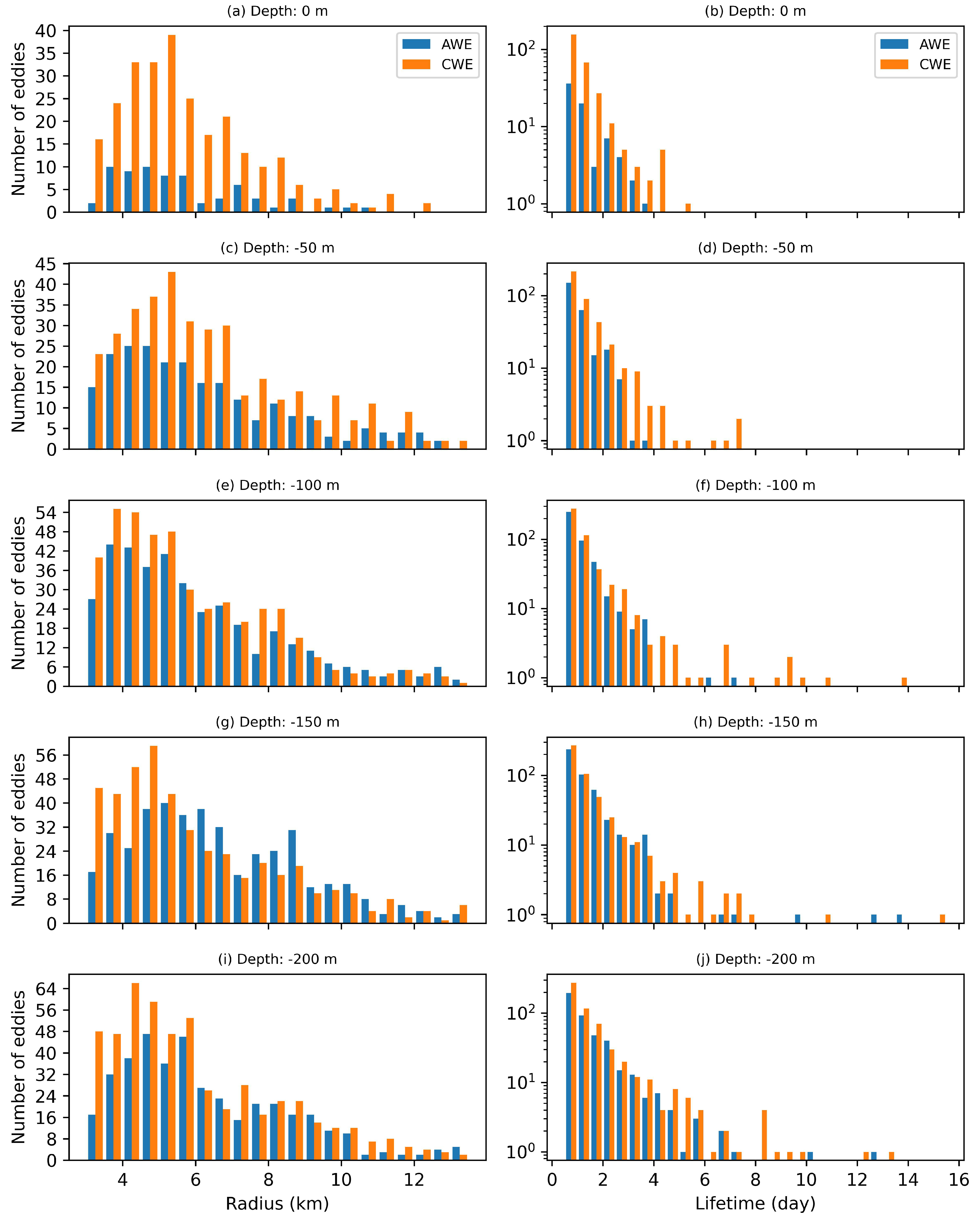
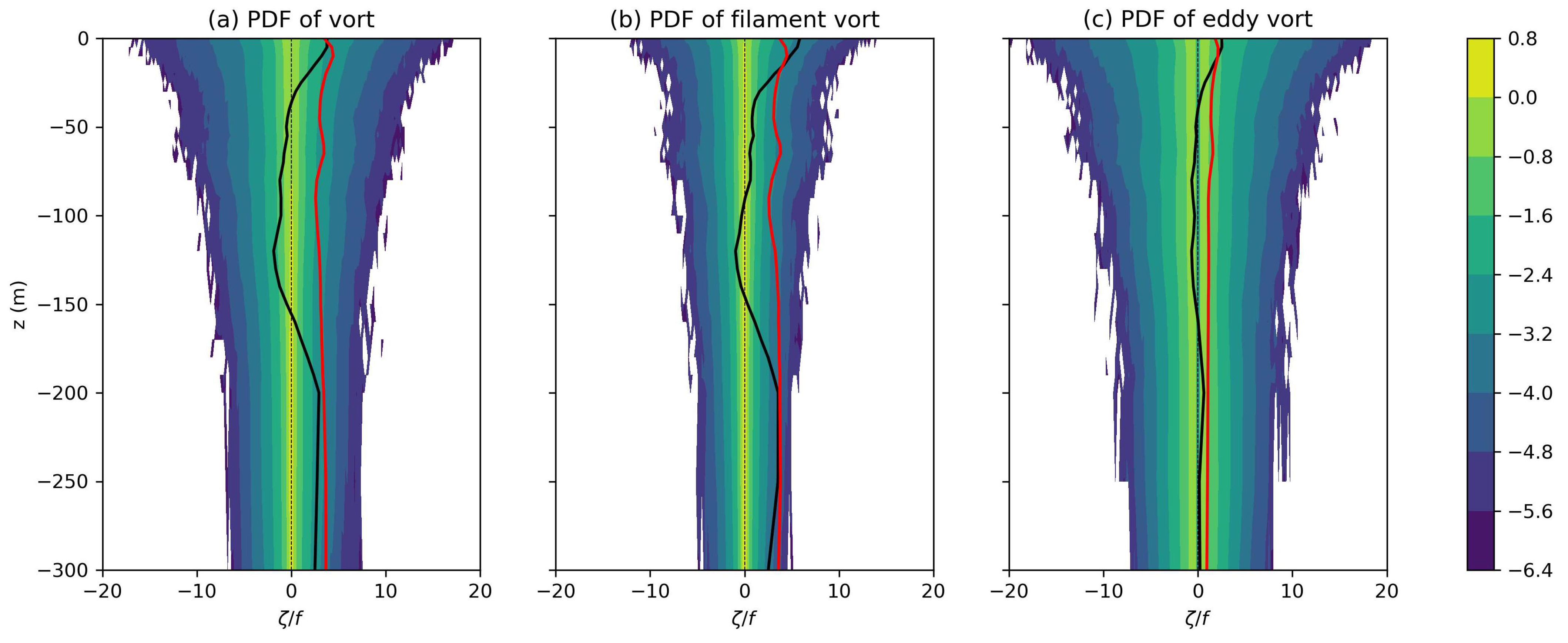
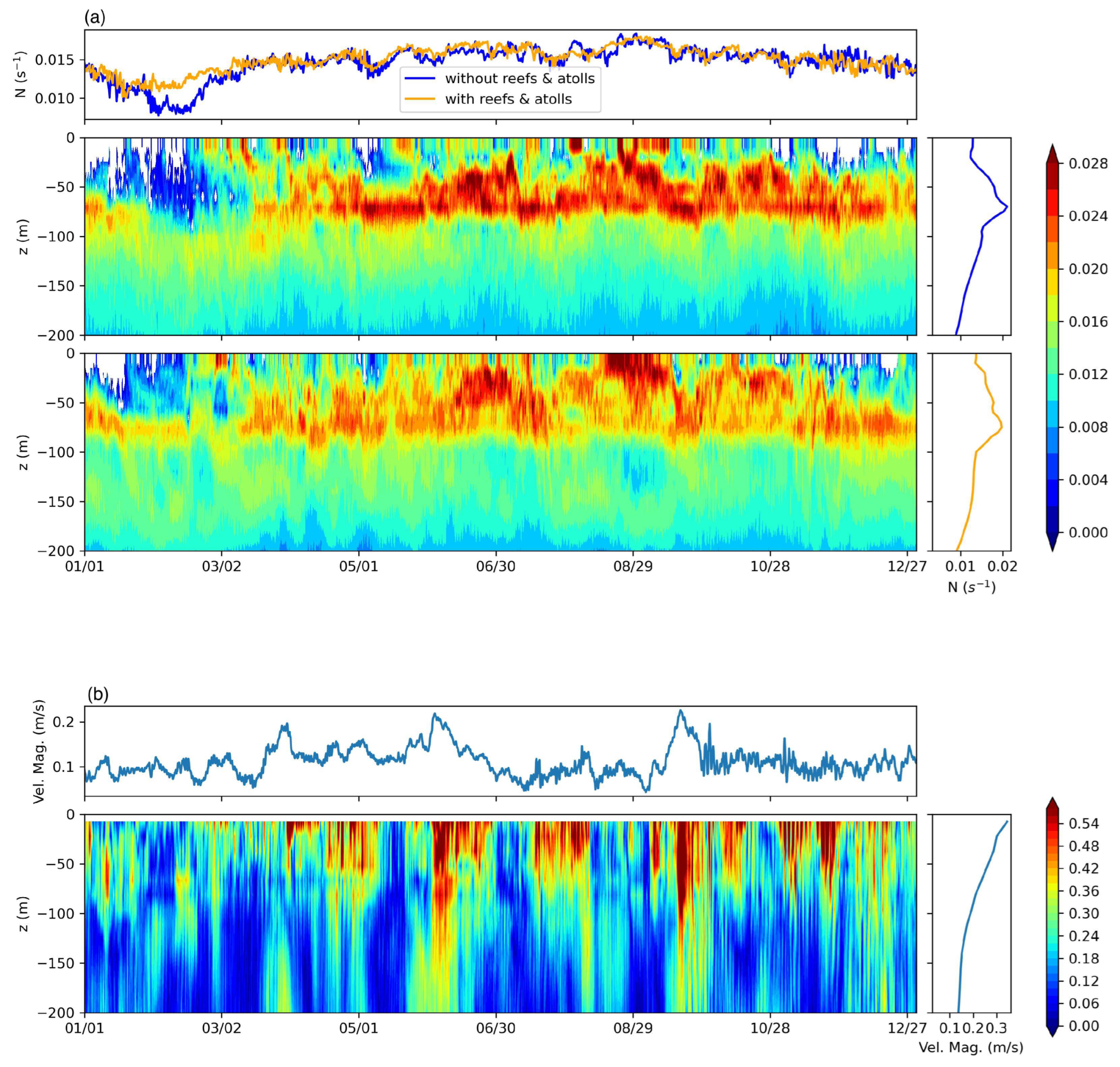
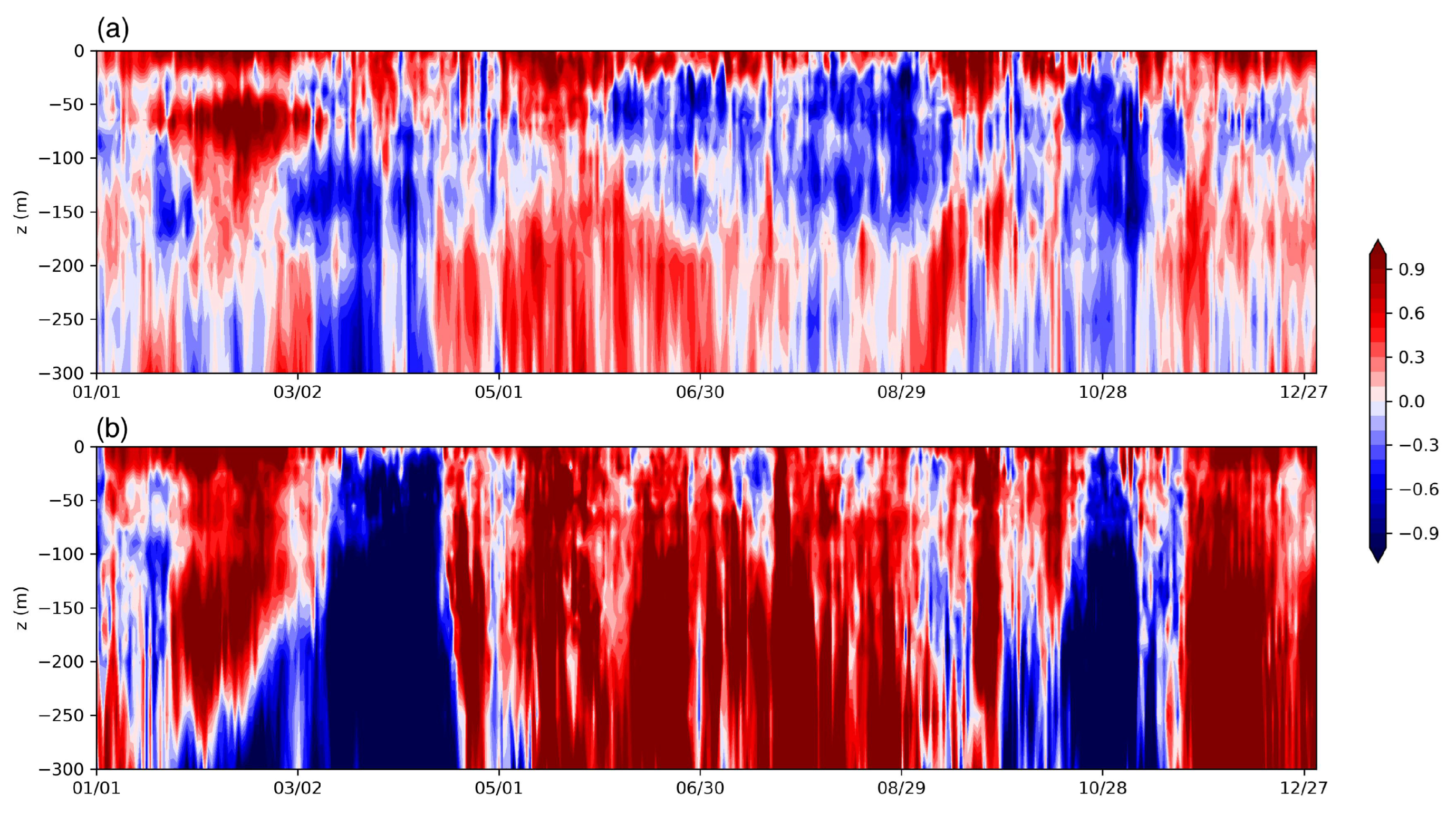
| Eddy Type | Water Depth | ||||
|---|---|---|---|---|---|
| 0 m | 50 m | 100 m | 150 m | 200 m | |
| CWE | 278 | 400 | 501 | 497 | 570 |
| AWE | 73 | 256 | 431 | 471 | 431 |
| Depth (m) | Parameters | |||||
|---|---|---|---|---|---|---|
| Ro | Bu | Core Vort. | r (km) | Lifetime (day) | ||
| 0 | Mean | 0.8 | 52.5 | −2.5 | 9.5 | 1.2 |
| Range | [0.2, 2.5] | [2.8, 239.2] | [−0.6, −6.3] | [3.2, 29.7] | [0.5, 3.6] | |
| 50 | Mean | 0.6 | 89.2 | −1.4 | 7.8 | 1.0 |
| Range | [0.1, 3.3] | [4.0, 625.7] | [−0.2, −8.1] | [2.0, 25.1] | [0.5, 3.9] | |
| 100 | Mean | 0.5 | 95.1 | −1.3 | 7.4 | 1.1 |
| Range | [0.1, 2.1] | [4.7, 664.9] | [−0.2, −4.6] | [1.9, 23.1] | [0.5, 7.4] | |
| 150 | Mean | 0.4 | 88.0 | −1.0 | 7.8 | 1.3 |
| Range | [0.1, 1.5] | [3.4, 1371.1] | [−0.1, −2.6] | [1.4, 27.0] | [0.5, 13.8] | |
| 200 | Mean | 0.4 | 90.9 | −1.0 | 7.4 | 1.4 |
| Range | [0.1, 1.8] | [4.4, 613.4] | [−0.2, −3.4] | [2.0, 23.9] | [0.5, 12.8] | |
Publisher’s Note: MDPI stays neutral with regard to jurisdictional claims in published maps and institutional affiliations. |
© 2022 by the authors. Licensee MDPI, Basel, Switzerland. This article is an open access article distributed under the terms and conditions of the Creative Commons Attribution (CC BY) license (https://creativecommons.org/licenses/by/4.0/).
Share and Cite
Zhao, Z.; Yan, Y.; Qi, S.; Liu, S.; Chen, Z.; Yang, J. Cyclonic and Anticyclonic Asymmetry of Reef and Atoll Wakes in the Xisha Archipelago. Atmosphere 2022, 13, 1740. https://doi.org/10.3390/atmos13101740
Zhao Z, Yan Y, Qi S, Liu S, Chen Z, Yang J. Cyclonic and Anticyclonic Asymmetry of Reef and Atoll Wakes in the Xisha Archipelago. Atmosphere. 2022; 13(10):1740. https://doi.org/10.3390/atmos13101740
Chicago/Turabian StyleZhao, Zhuangming, Yu Yan, Shibin Qi, Shuaishuai Liu, Zhonghan Chen, and Jing Yang. 2022. "Cyclonic and Anticyclonic Asymmetry of Reef and Atoll Wakes in the Xisha Archipelago" Atmosphere 13, no. 10: 1740. https://doi.org/10.3390/atmos13101740
APA StyleZhao, Z., Yan, Y., Qi, S., Liu, S., Chen, Z., & Yang, J. (2022). Cyclonic and Anticyclonic Asymmetry of Reef and Atoll Wakes in the Xisha Archipelago. Atmosphere, 13(10), 1740. https://doi.org/10.3390/atmos13101740







